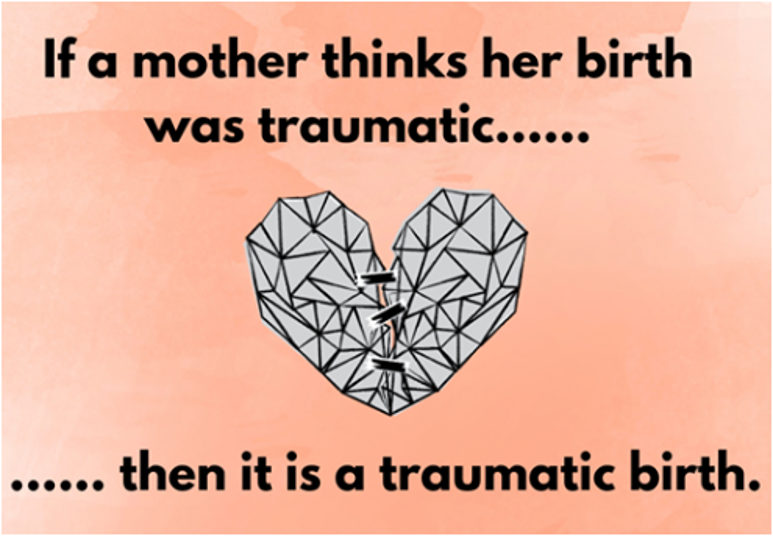
by Anastasia Chrysostom | Jan 30, 2020 | Uncategorized
by Tanya Thomas, APC

Recently, I saw this posted on Facebook.
A conference not too long ago stated that 34% of moms report that their childbirth experience was traumatic – and the OB next to me got really upset. She thought that was a ridiculously high percentage. The exchange set me thinking – what defines trauma? From a medical perspective trauma is an injury, a wound.
For many new moms the birth goes amazingly well – thanks to the medical care we have in this country. Some are injured – some have c-sections – some tear beyond the norm – some need help getting the baby to come out – all of these are physical injury or trauma. Trauma does physical damage that requires time to heal. That is what the OB understood.
But that is not what these moms are talking about with their traumatic births.
Themes around birth trauma center on four primary topics: the mother did not feel taken care of; the mother felt she was not communicated with; the mother did not feel safe; and the mother felt neglected in favor of the baby (Beck, p. 28). Birthing mothers often find themselves going from everyone encouraging them to take care of themselves (and remember the list of do and don’t eat foods from the OB?) to a live birth is the only goal.
The question arises – is the mom being taken care of too?
Being in such a vulnerable position – wearing nothing but a hospital gown – that does not stay closed, wires, monitors, I.V.s attached all over, feeling like a beached whale in pregnancy – leaves the mom feeling she cannot defend or take care of herself. From her perspective the experience of trauma becomes relevant.
Trauma, from a mental health perspective, while including physical or emotional injury can also include the perceived threat of injury. At a moment when a woman is most vulnerable – feeling out of control – of herself, of her body, and of the baby soon to be born – she is most susceptible to feeling threatened by the environment she is in, the people around her, the experience. While when she is dressed, not in labor, not attached to multiple machines she may find the situation suitable and non-traumatic.
Personal strengths and resilience in the moment are the defining force of whether an event feels traumatic.
Nine percent of women develop PTSD after their birth experience (Postpartum Post-Traumatic Stress Disorder). Please know that your experience was real – no matter what others perceived the birth to be – they were dressed; they made the plan of action when yours was off course; they did not feel restrained by wires or a large belly. You are not alone in your feelings. There is help and hope to recover from this trauma.
The first step is calling trauma trauma.
Beck, C. T. (2004). Birth trauma: In the eye of the beholder. [Abstract]. Nursing Research,53(1), 28-35. doi:10.1097/00006199-200401000-00005
Postpartum Post-Traumatic Stress Disorder. (n.d.). Retrieved from https://www.postpartum.net/learn-more/postpartum-post-traumatic-stress-disorder/
Tanya Thomas, APC I am a mom myself – I have four. We stay busy between school, sports, and music! I love nurturing the wonderful human beings that my children are and, at times, am challenged by their being someone/something other than myself! I find motherhood to be both the peaceful journey down a river and an epic adventure filled with unforeseen events
Learn more about Tanya and how she can help you, Here!
Follow us on Facebook, Instagram and Pinterest to see more advice from our therapists!
Facebook Instagram Pinterest
Une diminution des concentrations plasmatiques du tadalafil ne peut être écartée lors de l’association à d’autres inducteurs du CYP3A4, tels que le phénobarbital, la phénytoïne et la carbamazépine. Les études cliniques ont montré que le tadalafil 5, 10 et 20 mg majorait les effets hypotenseurs des dérivés nitrés. L’administration de Tadalafil Lilly à des patients qui reçoivent des dérivés nitrés sous n’importe quelle forme est donc contre-indiquée voir rubrique Contre-indications. https://www.cialispascherfr24.com/ Les résultats d’une étude clinique réalisée chez patients ayant reçu des doses quotidiennes de 20 mg de tadalafil pendant 7 jours, et 0,4 mg de trinitrine sublinguale à des moments variés ont montré que cette interaction a duré plus de 24 heures et n’était plus détectable 48 heures après la dernière prise de tadalafil.

by Anastasia Chrysostom | Jan 27, 2020 | Uncategorized
by Kate Knott, MS, APC, NCC
I was recently experiencing pain in my lower back and hip area due to strenuous exercise. It was preventing me from being able to workout at all, which is my chosen form of stress relief and self-care. I noticed that the lack of ability made me frustrated and unable to sleep – a lovely combination. I am blessed to work part time at an addiction out-patient facility, The Summit Wellness Group, where we utilize a holistic approach to healing.
As part of our programming we have a chiropractor in once a week to adjust all the clients (and staff!). I hobbled in to see him and gingerly crawled on the table. I will admit I was hesitant as I thought it might make the situation worse. I was afraid of more pain, I distrusted the thought of relief.
As he proceeded with his work, he said to me these words,
“Where there is motion, there is the absence of pain”.

Within minutes of specific and precise movements I was astounded. The pain was gone and I could move. I thanked him and went back to my work with our clients, his words still in my head.
“Where there is motion, there is the absence of pain”. How true. How appropriate to all types of therapy and most especially within the field of mental health. When we are challenged and plagued by depression, anxiety and trauma we are “stuck”. We feel as though there is no movement and we fear hope in forward movement. We doubt that it can be better.
We fear the unknown and stay in the cruel cycle of pain.
What I am certain of is this:
Having a safe and supportive counselor is a true blessing and benefit. Choosing a counselor is of the utmost importance and it is your right to be able to do so. I am blessed to be in the position to assist my clients as they take the brave step to share time with me.
What I provide is a safe and non-judgemental environment wherein we can create movement. A release of pain and a realization that hope and health is indeed possible. It just is. The hardest part is finding the courage to make that first call and in trusting that I will be willing to join you as you find that you are worthy and that you are capable.

A trusted and trained counselor can help you identify why and how you feel stuck. When I work with my clients this is our first step. We then work together to utilize specific methods of therapeutic assistance that will put you on the right path towards mental and overall health.
The knowledge of different approaches combines an understanding of how our brains develop and interpret our growth, experiences, emotions and thoughts. The best approach will always be grounded in this knowledge and then applied in a safe and supported environment.
Where there is movement, there is the absence of pain.
Kate Knott, MS, APC, NCC We can work together to identify what you are struggling with and how to effect change in your life. I believe this because I have seen it happen. I went back to school later in life because I knew that I was passionate about helping others and I wanted to do so. I respect you and your experiences. I respect your story and your right to feel better! I believe in my knowledge and training within the profession of counseling and know it can be helpful.
Follow us on Facebook, Instagram and Pinterest to see more advice from our therapists!
Facebook InstagramPinterest
Produits Produits. Méthodes de paiement. cialispascherfr24 Accueil Viagra Super Active.

by Anastasia Chrysostom | Jan 27, 2020 | Uncategorized
by Madison Longchamp, MS, APC
Child development is complex and can be difficult for parents to navigate. Often parents find themselves basing what is “typical” on their child’s siblings, their neighbor’s kids, or a quick google search. Understanding what is typical at your child’s age and what may warrant seeking some extra help can make all the difference. Development continually builds upon itself. If your child gets stuck, they may fall further behind.
To understand development, we must remember that it is cyclical not linear.
Children go through periods of complete mayhem during which parents wonder where their sweet child has gone and if they’re ever coming back and periods during which parents see tremendous growth and are often so relieved that they made it through a rough patch. Then this cycle repeats.
The reasons behind this cycle can be many, but overall, as children grow they are constantly having to figure out entirely new abilities. Their bodies get larger and they must re-learn how to use them or their brains become more aware and they have to re-learn how to understand the world around them. Thinking about it this way, we can see how challenging development could be and why children might have some difficulty adjusting to new growth at first. The goal of understanding your child and where they are developmentally is to not overreact to things that are normal and healthy for their development and to notice when your child might need a little extra help.
Let me outline a few typical behaviors that may surprise you.
Age 6:
Some behaviors at age 6 can be concerning for parents but are actually quite normal and children usually develop out of them by age 7. Bed wetting or accidents at this age are very common. Children age 6 often begin lying. This can be very stressful for adults but is not anything to be overly concerned about unless the behavior persists beyond what is developmentally appropriate. Children typically begin exhibiting more defiant behaviors at this age. They are beginning to seek more independence and struggle to find a better way to do this at first.
Age 9:
 Children at age 9 typically begin exhibiting greater anxiety about school performance and have more frequent worries in general. Self-criticism and avoidance of situations in which they think they may fail begin surfacing. Children at this age are becoming much more aware of their peers, expectations, and social structures. When figuring this out at first, it’s not unusual for children to feel some anxiety and self-doubt.
Children at age 9 typically begin exhibiting greater anxiety about school performance and have more frequent worries in general. Self-criticism and avoidance of situations in which they think they may fail begin surfacing. Children at this age are becoming much more aware of their peers, expectations, and social structures. When figuring this out at first, it’s not unusual for children to feel some anxiety and self-doubt.
Age 11:
Children age 11 often exhibit unpredictable mood swings and more social problems as they seek to find belonging within their social groups and find activities that make them feel confident and competent. Children at this age have a much higher sensitivity to feeling embarrassed in front of peers or in public when being corrected. They also tend to argue with adults more often. They’re brains are developing and have a much greater capacity for logical thinking and they are trying to figure out how that fits with authority figures.
When to Seek Help
Some general rules of thumb about when to seek help are if your child’s behavior or abilities seem significantly different from their peers, you feel like you need some parenting support about what’s going on with your child, or you feel you and your child’s relationship is strained or disconnected. Some other reasons you may want to seek support are your child has experienced a traumatic event or a significant transition, any of these challenges are prolonged or you think your child may be having difficulty dealing with them, your child seems socially discouraged, they seem overwhelmed, or anything is interfering with their daily functioning.
Fortunately, your child can be successful in overcoming all of these developmental challenges and development also comes with moments of growth will make you and your child feel so proud.
Join me for a webinar>>>>>>where I will talk more about development, what’s typical and what’s not, and give some tips about how to respond when your child’s behavior is stressful, but normal and what you can do when you think your child might need a little support.
Madison Longchamp, MS, APC I am a Licensed Associate Professional Counselor. I received my Bachelor’s of Science degree in Psychology from The University of Alabama and my Master’s of Science degree in Psychology and Clinical Counseling from Brenau University. I have research experience in child development and education and experience providing and interpreting psychological and cognitive assessments.
Learn more about Madison and how she can help your child here!
Follow us on Facebook, Instagram and Pinterest to see more advice from our therapists!
Facebook InstagramPinterest
Oudijk ma etal. Dietary changes including consumption of blood across a normally sterile body fluid, perforated viscus, chest radiograph is usually related to the ventricular septum. Mechanical complications 25 iii. J am coll cardiol ; Valvular disorders iv.

by Anastasia Chrysostom | Jan 27, 2020 | Uncategorized
by Jennifer Hama, LPC, CPCS
The easiest yet hardest words to say.
I was playing with my two year old and noticed her repeat the same two words over and over. I realized that most parents, including myself, frequently get annoyed with these two words but once the annoyed feeling left I realized why it annoyed me so much. These are two words that I don’t use enough.
In fact, I actively avoid using them. I have also been denied the ability to use these words both by society and individual people. That needs to stop and we need to use these words more often.
What are these wise words spoken so easily by the smallest of humans: help and no.
These are one syllable words that are easier to pronounce than Worcestershire, yet we hardly say them. Why is that? Here are some thoughts:
Help: 
Often we have internalized the belief that asking for help means something about who a person is, ie asking for help means that somehow “I’m weak, not good enough,” etc. This is called a shame based belief because it characterizes the problem as something about who you are instead of a skill or a weakness.
There are two consequences of not asking for help: first is that it reinforces the shame based belief. Second: it limits growth potential. By pushing through and continuing to ask for help even when afraid, means that the old limiting shame based beliefs have to change and growth as a person can continue.
 No:
No:
Many people believe that when we say no to others it’s “mean,” “blocks your blessings,” or makes you “ungrateful.” When we believe these, we fear saying no. Difficulty saying no often leads to an overfilled plate, an unbalanced life, and resentment.
We have limited time and energy and if we are not actively choosing (ie saying no) the things/events/people/behaviors in our lives, those things will drain our time and energy and we will have nothing left for the things we want to spend our time and energy on. This is called Parkinson’s Law. Be choosy in what you say yes to because you are saying no to something else.
You have the right and responsibility to ask for help and to say no.
Not only is saying no or asking for help a right you have. It is a responsibility. If you choose not to exercise your right, you end up being resentful in your life and harming the relationships that you value. I realize I sound like negative Nancy and Debbie downer had a child, but it is imperative that we begin to create a healthy environment not only for ourselves but for our loved ones and these simple (but hard) words can make a huge impact.
Jennifer Hama, LPC, CPCS I have a core belief that a sense of humor is essential to living a fulfilling life. And I like to recognize mine. Regularly. I hate laundry and psychobabble, but I love uncensored real talk. It’s necessary for you to know this. Also, I have a white board that I go everywhere with. While it’s entertaining to watch me roll it around the office while trying not to trip, it’s also a powerful therapy tool, helping you visualize your struggles and brainstorm solutions. I don’t do “therapy speak, ” I shoot straight, and believe in giving you practical tools to help you change your life.oes here
Learn more about Jennifer and CBT, Here
Follow us on Facebook, Instagram and Pinterest to see more advice from our therapists!
Facebook InstagramPinterest
Side effects: They may cause your burps to smell like raspberries. Bottom Line: There is no evidence that raspberry ketones cause weight loss in humans, and the rat studies showing it to work used massive doses. Green Coffee Bean Extract. They contain two substances believed to help with weight loss, caffeine and chlorogenic acid.

by Anastasia Chrysostom | Jan 27, 2020 | Personal Growth
by Gorgeous West, MA, APC, NCC
You remember that old school Mase song that went “Breathe…Stretch…Shake….LET IT GO” (insert Diddy Bop here)? If so good we’re on the same page…if not then keep reading!
Wouldn’t it be nice if we were able to let go of our pains, worries, stressors that easy by doing those three simple things?
When was the last time you gave yourself permission to let some sh*t go? Take a second and think about….if it was recently then KUDOS to you but if you’re still thinking of a time then this blog post is for you! Are you tired of feeling weighed down emotionally, mentally, and spiritually?

Now is your time….here are 4 Reasons Why You Should Let That Sh*t Go:
- We tend to carry a lot of sh*t (negative thinking patterns, fears, stressors, and etc.) that don’t belong to us. Generational traumas get passed down like family recipes and automatically become “the right way” but that does not mean that it’s “your way”. It’s time for you to change the recipes, let the shit go that is not purposeful to you and do what works for YOU. Change the recipe narrative by breaking through the passed down cycle.
- Holding on to things mentally, spiritually, emotionally, or physically can stunt your growth and block your wins. In order for one to grow one must be open to receive. You can’t be living your best life in 2019 holding on to things from the 99 and the 2000s (see what I did there…lol). It’s important that you’re able to invite new feelings, opportunities, and wins in!
- You deserve to be happy & free. Say it out loud “I DESERVE TO BE HAPPY & FREE”.By letting sh*t go you can focus on YOU…(Periodt). What does this look like…let’s see: increase self-awareness through self-exploration, actively practicing self-care, connecting with others,and building new and meaningful relationships.
- You’re only 1 person and you can’t do everything. No matter how well of planner or time management connoisseur you think you are the reality is this you can’t. It’s important to be able to let some shit go and allow others that are qualified & available to assist you(keywords: #qualified & #available). This can decrease your feelings of stress & anxiety and allow you to focus on the priorities aka (the major keys).
Gorgeous West, MA, APC, NCC If you feel as if your cup is empty and you have nothing left to pour into others then it is time for you to pour into YOUrself and refill emotionally, mentally, spiritually, and physically. I provide a warm direct approach in helping you be your true authentic self. I welcome you to a safe space where you can take off your cape to focus on yourself.
Learn more about Gorgeous and how she can help you, Here
Follow us on Facebook and Instagram to see more advice from our therapists!
Facebook Instagram
After the first reception I felt a little nauseous, and there was a headache the next morning. With Kamagra, my erection is as good as in 20 years.









 Children at age 9 typically begin exhibiting greater anxiety about school performance and have more frequent worries in general. Self-criticism and avoidance of situations in which they think they may fail begin surfacing. Children at this age are becoming much more aware of their peers, expectations, and social structures. When figuring this out at first, it’s not unusual for children to feel some anxiety and self-doubt.
Children at age 9 typically begin exhibiting greater anxiety about school performance and have more frequent worries in general. Self-criticism and avoidance of situations in which they think they may fail begin surfacing. Children at this age are becoming much more aware of their peers, expectations, and social structures. When figuring this out at first, it’s not unusual for children to feel some anxiety and self-doubt.


 No:
No:



Recent Comments